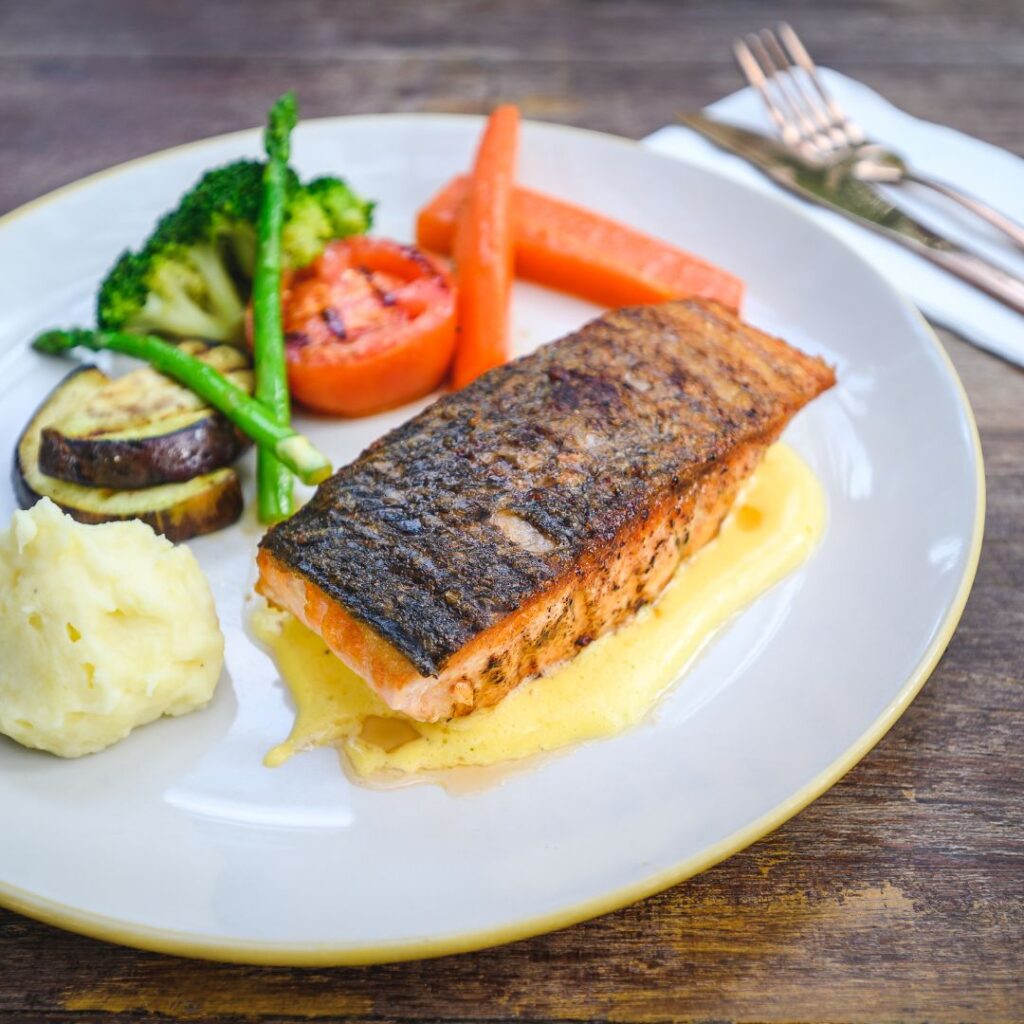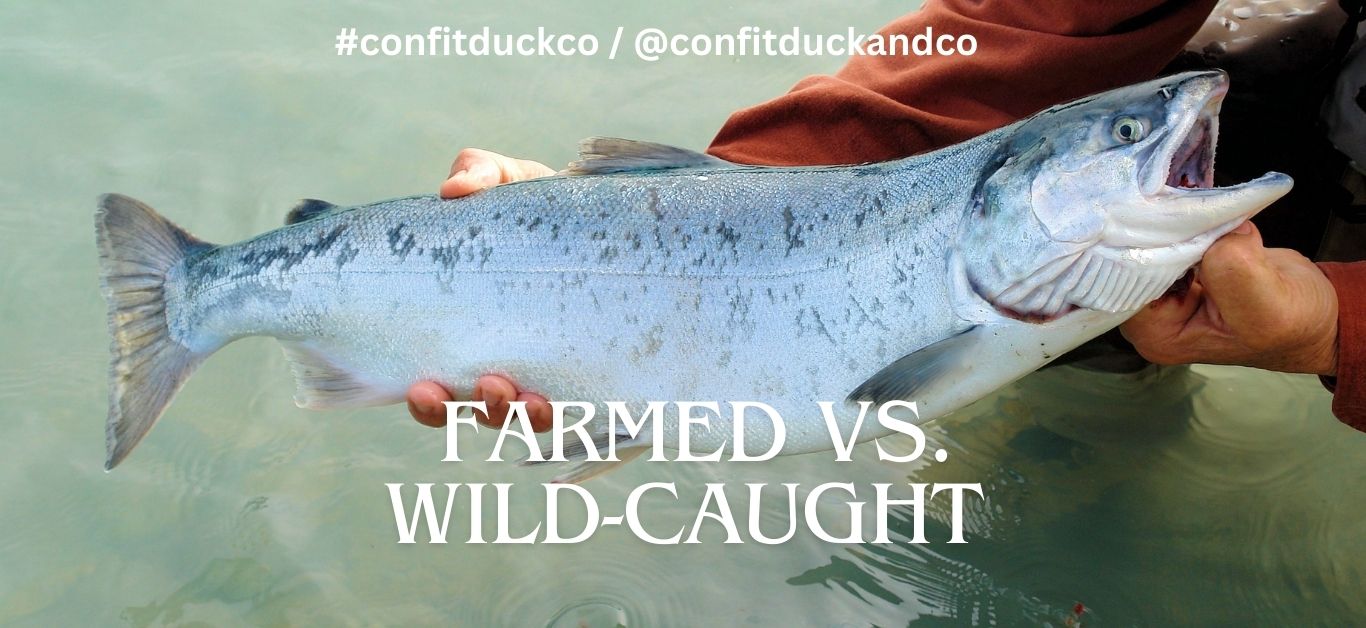Salmon, a staple in many diets around the world, comes in two main varieties: farmed and wild-caught. Each has its own set of characteristics, flavors, and environmental considerations. In this blog, we’ll delve into the differences between farmed and wild-caught salmon, and then explore a simple yet effective method for searing salmon skin to perfection.
Farmed vs. Wild-Caught Salmon:



Salmon comes in two main varieties—farmed and wild-caught. Farmed salmon, nurtured in controlled aquaculture farms, boasts a milder flavor, softer texture, and higher fat content. However, concerns about sustainability, antibiotic use, and environmental impacts linger. On the other side, wild-caught salmon, plucked from its natural habitat, showcases a robust flavor, firmer texture, and a vibrant color profile. The choice between the two hinges on personal preference and considerations for environmental impact and sustainability.
Environmental Impact:
Farmed salmon, though providing a consistent supply, raises concerns about pollution and its impact on wild fish stocks. Contrastingly, sustainable practices in wild-caught salmon fisheries contribute to maintaining ecological balance.
How do you distinguish between the two?
When shopping for salmon fillets at the supermarket, there are several visual and labeling cues that can help you distinguish between farmed and wild-caught salmon. Here are some key factors to look for:
- Color and Texture:
- Farmed Salmon: Farmed salmon often has a more consistent and lighter color. The flesh can appear pink, but it may lack the rich and vibrant hue associated with wild-caught salmon. The texture tends to be softer.
- Wild-Caught Salmon: Wild-caught salmon typically has a deeper, more intense color, ranging from reddish-orange to deep pink. The flesh is firmer, reflecting the fish’s natural, active lifestyle.
- Fat Content:
- Farmed Salmon: Due to their controlled environment and feed, farmed salmon may have higher fat content, resulting in a richer taste and softer texture.
- Wild-Caught Salmon: Wild-caught salmon tends to be leaner with less fat, offering a firmer texture and a distinct, robust flavor.
- Price and Labeling:
- Farmed Salmon: Farmed salmon is often more readily available and can be less expensive than wild-caught varieties. Look for labels that explicitly state “farm-raised” or “Atlantic salmon,” as most Atlantic salmon available in supermarkets is farmed.
- Wild-Caught Salmon: Wild-caught salmon is generally pricier due to its seasonal availability and the challenges of catching fish in their natural habitat. Look for labels such as “wild-caught,” “Alaskan salmon,” or the specific type of wild-caught salmon (e.g., sockeye, coho).
- Skin and Scales:
- Farmed Salmon: The scales of farmed salmon may be smoother and more uniform, and the skin may appear less vibrant in color.
- Wild-Caught Salmon: Wild-caught salmon often has more irregular and defined scales, and the skin may display a more vibrant and natural coloration.
- Origin Information:
- Farmed Salmon: Check for information on the packaging that indicates the country or region of origin. Commonly, farmed salmon is sourced from countries with significant aquaculture operations, such as Norway or Chile.
- Wild-Caught Salmon: Labels for wild-caught salmon often specify the region or country where the fish was caught. For example, Alaskan wild-caught salmon is a popular and sustainable choice.


By paying attention to these characteristics and reading the labels carefully, you can make informed choices when selecting salmon fillets at the supermarket based on your preferences and considerations for sustainability.
Searing Salmon Skin to Crispy Perfection:
Now, let’s turn our attention to enhancing the dining experience by mastering the art of searing salmon skin. Follow these steps for a delectable crispy skin:
- Pat Dry: Ensure the salmon skin is dry to promote crispiness. Use a paper towel to remove excess moisture.
- Season Liberally: Season the skin with salt and pepper. Feel free to add herbs or spices for extra flavor.
- Preheat the Pan: Heat a skillet over medium-high heat. Add a small amount of oil, enough to coat the bottom of the pan.
- Place Skin-Side Down: Lay the salmon in the pan with the skin side down. Press gently to ensure even contact with the hot surface.
- Be Patient: Allow the skin to sear undisturbed for 4-5 minutes. This promotes a crispy texture.
- Flip Carefully: Once the skin is golden brown and crispy, carefully flip the salmon using a spatula.
- Brief Finish: Cook the flesh side briefly to finish, keeping it moist while maintaining the crispy skin.


Whether opting for the consistency of farmed salmon or the wild allure of its counterpart, understanding the distinctions enhances your culinary experience. Meanwhile, perfecting the searing technique transforms your salmon into a crispy, delectable delight. Navigate the choices, savor the flavors, and enjoy the best of both worlds on your plate.


No Comments